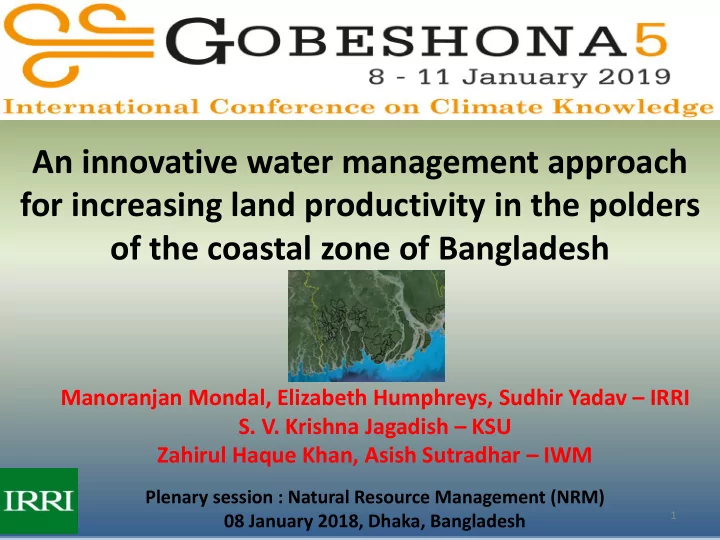

An innovative water management approach for increasing land productivity in the polders of the coastal zone of Bangladesh Manoranjan Mondal, Elizabeth Humphreys, Sudhir Yadav – IRRI S. V. Krishna Jagadish – KSU Zahirul Haque Khan, Asish Sutradhar – IWM Plenary session : Natural Resource Management (NRM) 12-Jan-19 1 08 January 2018, Dhaka, Bangladesh
Take home message Coastal zone is rich with water resources , offers HUGE POTENTIAL for Bangladesh to make a quantum leap in meeting FUTURE FOOD SECURITY requirements and achieving SDG 1 & SDG 2 (No Poverty & Zero Hunger) 1.2 Mha lands in polders underutilized Improved appropriate agricultural technologies Wet Season Dry Season
Take home message WATERLOGGING is the main constraint, not the SALINITY July September August November May DRAINAGE in aman season is the key intervention and the ENTRY POINT for cropping system INTENSIFICATION in CZ
Take home message Because of hydrology, INDIVIDUAL alone cannot successfully adopt improved agricultural technologies in the polders of the coastal zone COMMUNITY coordination within a hydrological unit is Hydrological unit necessary for wide-scale adoption of improved agricultural technologies
Coastal zone and polders • Coastal zone is the most climate vulnerable region of the Ganges delta • Home to the poorest, most food insecure, vulnerable people • GoB constructed 139 polders to protect 1.2 M-ha low lying coastal areas from tidal flood and saline water intrusion • Productivity is very low, much less than most of Bangladesh – missed out of Green Revolution
Coastal ecosystem & hydrology Sluice gate/regulator Q ~ 6-26 m3/s
Coastal ecosystem & hydrology • Different hydrology and agro- environments • Hydrology is governed by
Perceived challenge: Salinity May 2012 • Water salinity o SC region: fresh water (2030) o SW region: saline + fresh BARISAL • Soil salinity KHULNA o ~ 75% land low & medium saline o ~ 25% land highly saline May 2030 CC(A1B) w 22 cm SLR o Salt-tolerant crops o Management practices • High salinity is an OPPORTUNITY – Shrimp-(rice+fish) – Year-round aquaculture
Improved agro-technologies for high saline coastal zone Jan Feb Mar Apr May Jun Jul Aug Sep Oct Nov Dec
Existing cropping in polders (farmers’ practice) Jun Jul Aug Sep Oct Nov Dec Jan Feb Mar Apr May Jun Traditional Climate Risky (2-7 t/ha)
Improved & climate-resilient agro-technologies for CZ May Jun Jul Aug Sep Oct Nov Dec Jan Feb Mar Apr May Tidal river water + rainfall Pump from polder canal Low saline REY: 15-21 t/ha/yr Medium saline REY: 7-10 t/ha/yr High saline Rice: 3 t/ha Shrimp: ~300 kg/ha Fish: ~3 t/ha
Why productivity LOW? Despite huge efforts from GoB NGOs Development partners International orgs HIGH Because of Hydrology o Inappropriate o LOW o Hypothesis o Technology dissemination model
How to overcome CHALLENGE ? Sluice gate/ Agriculture regulator managed managed by by DAE BWDB • Coordination between • Bangladesh Water Development Board (BWDB) and • Department of Agricultural Extension (DAE) is needed for wide-scale and year-round adoption of improved production systems in the polders of the CZ
How to overcome CHALLENGE ? • Community Coordination and Synchronized Cropping based on Hydrological Unit are required for wide-scale adoption of improved production systems in CZ • Water Management Organizations should be formed based on Hydrological unit hydrological unit not by geographical area (village)
Why synchronized cropping & community involvement? Polder 30: Khulna The ENTRY point for cropping intensification is HYV rice in aman Polder 43/2F: Barguna HYV rice harvested on 3 Nov 2016 in polder 30 HYV rice harvested on 20 Nov in polder 43/2F
Why synchronized cropping & community involvement? Community water management creates opportunities for early establishment safe harvest of rabi crops Dibbling sunflower on 17 Dec 2015 (2 months earlier than FP) Sesame/mungbean on 30 Jan 2016 ~3 weeks earlier than FP
Why synchronized cropping & community involvement? May Jun Jul Aug Sep Oct Nov Dec Jan Feb Mar Apr May Jun Traditional Climate Risky (2-7 t/ha/yr) Improved and Climate Resilient Low saline REY: 15-21 t/ha/yr Medium saline REY: 7-10 t/ha/yr
Concluding remarks: Food Security/SDG Community water management and synchronized climate- resilient cropping is necessary for cropping intensification in CZ. If the improved production system is adopted to 50% of the 1.2 Mha polder area, ~ 5 MILLION TONS ADDITIONAL FOOD GRAINS can easily be produced per year (SDG 1 and SDG 2) 12-Jan-19 18
Recommend
More recommend